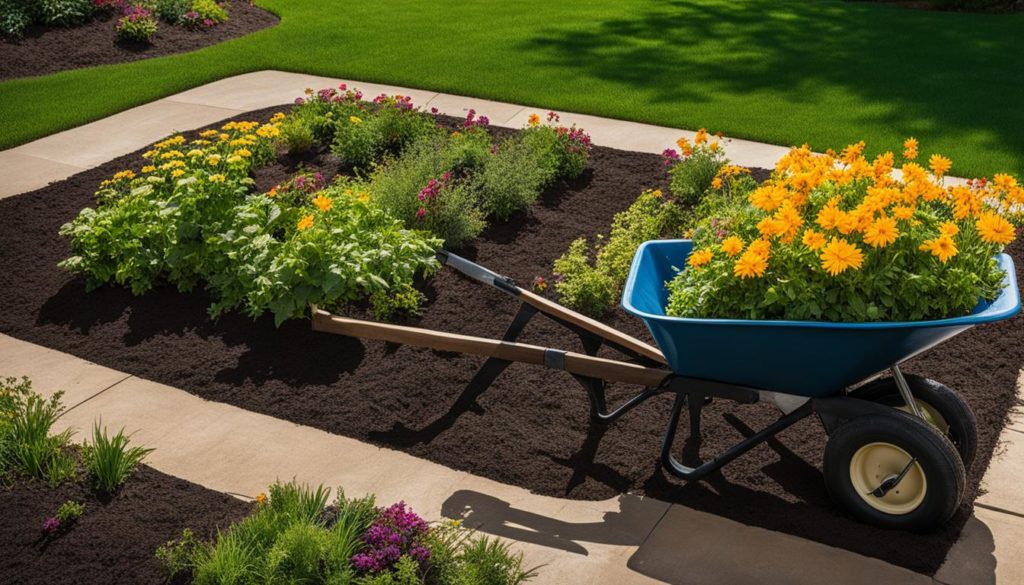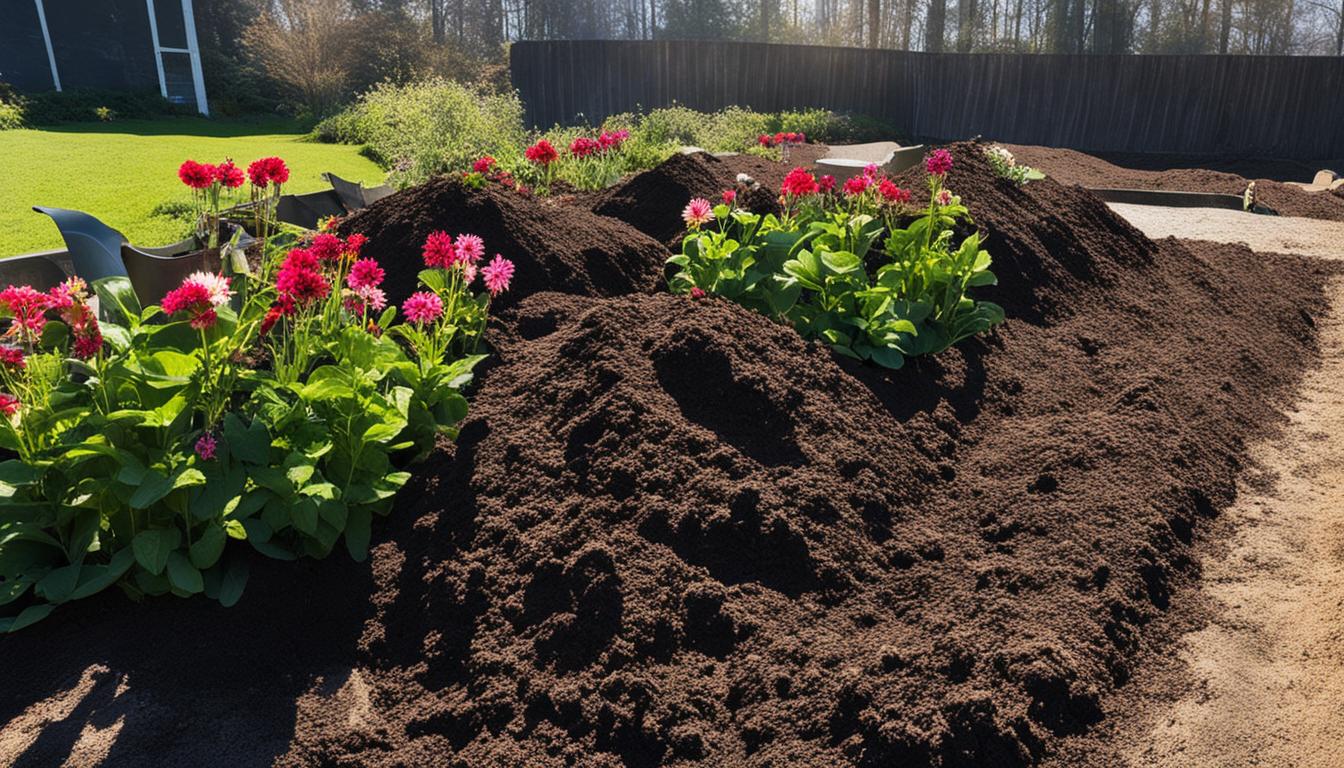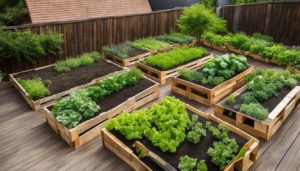Mulching flower beds is an essential practice for maintaining the health and appearance of your plants. By understanding how often to mulch and the best timing for mulching, you can ensure optimal benefits for your flower beds.
Key Takeaways:
- Mulch flower beds at least once a year for optimal benefits.
- Mulching provides aesthetic improvements and nutrients to the soil.
- Choose the right time to mulch, typically in the spring or fall.
- Proper mulch application techniques are crucial for plant health.
- Understanding different mulch materials helps in selecting the right one.
Benefits of Mulching Flower Beds
Mulching flower beds offers a range of benefits that extend beyond enhancing the visual appeal of your garden. By understanding the advantages of mulching, you can make informed decisions and optimize the health of your plants.
1. Nutrient Enrichment:
Mulch acts as a natural source of nutrients for the soil as it decomposes over time. This process releases essential minerals and organic matter, enriching the soil and promoting healthier plant growth. The nutrients provided by mulch contribute to vibrant blooms, strong root systems, and improved overall plant vigor.
2. Weed Suppression:
One of the key reasons to mulch flower beds is its ability to suppress weed growth. A layer of mulch acts as a barrier, preventing sunlight from reaching weed seeds and inhibiting their germination. This not only reduces the time and effort required for weed removal but also minimizes competition for water and nutrients, allowing your plants to thrive.
3. Soil Moisture Regulation:
Mulching flower beds helps regulate soil moisture levels by slowing down evaporation. The layer of mulch acts as insulation, shielding the soil from extreme temperature fluctuations and reducing water loss due to evaporation. This helps conserve water, ensuring that your plants have a consistent and adequate supply for optimal growth.
In addition to these primary benefits, mulching flower beds can also improve soil structure, prevent erosion, and promote beneficial soil microorganisms. By considering these advantages, you can make informed decisions when mulching your flower beds, resulting in healthier plants and a more vibrant garden overall.
Choosing the Right Time to Mulch
Mulching flower beds at the right time is essential to optimize its benefits and maintain the health of your plants. When determining the best time for mulching, consider the specific needs of your flower beds and the local climate. While some gardeners prefer to mulch twice a year, it is generally recommended to mulch annually.
The ideal timing for mulching is either just before or just after the growing season. This typically falls in the spring or fall, depending on your region. Mulching in the spring offers several advantages. It gives your flower beds a fresh look, enhances the aesthetic appeal of your garden, and helps plants recover from the harsh conditions of winter.
On the other hand, mulching in the fall provides insulation for the soil during the colder months and can benefit soil health in the long run. By mulching in the fall, you create a protective layer that regulates soil temperature, reduces moisture loss, and suppresses weed growth. Additionally, it can help prevent erosion and protect the roots of your plants from frost damage.
Factors to Consider:
- The climate of your region
- The specific needs of your flower beds
- The types of plants you are growing
- The availability of mulching materials
- Your personal gardening preferences
Keep in mind that these are general guidelines, and the best time for mulching may vary depending on your specific circumstances. It’s always a good idea to consult with local gardening experts or extension services for tailored advice based on your region and plant varieties. By choosing the right time to mulch, you can maximize the benefits and ensure the long-term health and beauty of your flower beds.
Proper Mulch Application Techniques
When it comes to mulching flower beds, applying the mulch correctly is key to ensuring the health and vitality of your plants. Here are some essential techniques to follow:
1. Create Space Around Plant Stems
Avoid direct contact between the mulch and the stems of your plants. This helps prevent suffocation and water deprivation. Instead, create a small circle or “donut” of empty space around each plant base. This allows for proper air circulation and watering, promoting healthy growth.
2. Determine the Ideal Depth
The depth of your mulch layer will depend on how often you plan to replace it. As a general guideline, aim for a depth of two to four inches. However, be cautious not to apply too much mulch at once, as this can lead to excessive moisture retention and ultimately harm your plants.
3. Turn Over the Mulch
Before replacing your mulch, it’s beneficial to turn over the existing layer. This helps the mulch decompose and enrich the soil with nutrients. Simply use a garden fork or rake to gently mix the mulch, promoting its breakdown and improving soil health over time.
4. Monitor and Maintain
Regularly inspect your mulch for signs of mold, fungus, or pests. If necessary, remove and replace any affected areas promptly. Additionally, periodically check the mulch depth and adjust as needed to maintain the desired two to four-inch layer.
By following these proper mulch application techniques, you can ensure that your flower beds receive the maximum benefits from mulching and help your plants thrive.

| Technique | Description |
|---|---|
| Create Space Around Plant Stems | Avoid direct contact between mulch and plant stems to prevent suffocation and water deprivation. |
| Determine the Ideal Depth | Apply a two to four-inch layer of mulch, based on how often you plan to replace it. |
| Turn Over the Mulch | Gently mix the mulch before replacing it to promote decomposition and enrich the soil. |
| Monitor and Maintain | Regularly inspect your mulch for issues such as mold, fungus, or pests, and adjust the depth as needed. |
Understanding Mulch Materials
Mulching flower beds involves selecting the right materials to provide optimal benefits for your plants. There are various types of mulch available, both organic and inorganic, each with its unique characteristics and considerations. By understanding the different options, you can choose the most suitable mulch for your flower beds.
Organic Mulch Options
Organic mulch materials are derived from natural sources and offer several advantages. Shredded hardwood is a popular choice as it breaks down slowly, providing long-lasting weed suppression and soil improvement. Pine bark is another excellent option, known for its ability to retain moisture and regulate soil temperature effectively.
Grass clippings, leaves, and pine needles are readily available materials that can be used as mulch. They decompose quickly, returning nutrients to the soil, and help suppress weed growth. Sawdust is another organic mulch option that can be used, especially for acid-loving plants. Leguminous hay, straw, and compost are also commonly used organic mulches that offer multiple benefits, including fertility improvement and weed control.
Inorganic Mulch Options
In addition to organic materials, there are also inorganic mulch options available. Pebbles, stone chips, and gravel can be used to create visually appealing flower bed borders or walkways. These materials do not break down, providing a long-lasting option for low-maintenance areas. They also help with soil moisture retention and weed suppression.
When choosing an inorganic mulch, consider the aesthetics and purpose of your flower beds. These materials are ideal for areas where you want to create a decorative effect or need a more permanent solution. However, they may not provide the same soil improvement benefits as organic mulches.
| Organic Mulch | Advantages | Considerations |
|---|---|---|
| Shredded hardwood | Long-lasting weed suppression and soil improvement | Breaks down slowly |
| Pine bark | Effective moisture retention and soil temperature regulation | May attract termites in some areas |
| Grass clippings, leaves, pine needles | Quick decomposition, nutrient return, and weed suppression | May become compacted if applied too thickly |
| Sawdust | Beneficial for acid-loving plants | May deplete nitrogen if not properly composted |
| Leguminous hay, straw, compost | Improves fertility and suppresses weeds | May introduce weed seeds if not properly composted |
By considering the different types of mulch materials available, you can select the most suitable option for your flower beds. Evaluate your specific needs, such as weed control, moisture retention, and soil improvement, to make an informed decision. Remember to apply mulch with the proper thickness and maintain it regularly to ensure its effectiveness in supporting the health and growth of your plants.
Common Mistakes to Avoid
When mulching flower beds, it’s important to be aware of common mistakes that can hinder the health and growth of your plants. By avoiding these mistakes, you can ensure that your mulching efforts are effective and beneficial.
Avoid Over-Mulching
One of the most common mistakes when mulching flower beds is over-mulching. Applying too much mulch can lead to excessive moisture retention, which can suffocate plant roots and cause root and bark rot. To prevent this, make sure to apply mulch at the recommended depth of two to four inches and avoid piling it up around the base of plants.
Timing is Key
Another mistake to avoid is applying mulch too early or too late in the season. Mulching too early can prevent the soil from warming up properly, which can delay plant growth. On the other hand, mulching too late can disrupt the dormancy period of certain plants. It’s essential to mulch at the right time, either in the spring or fall, to provide the best conditions for your plants.
Avoid Mulching Grassy Areas
Lastly, it’s important to avoid mulching grassy areas. Mulch can prevent grass from growing, leading to patchy or bare spots in your lawn. When mulching flower beds, take care to keep the mulch within the designated areas and away from the grass to maintain a healthy and thriving lawn.
By being aware of these common mulching mistakes and taking the necessary precautions, you can ensure that your flower beds thrive and flourish. Remember to follow proper mulching techniques and consider the specific needs of your plants when applying mulch. Avoid over-mulching, time your mulching correctly, and keep the mulch away from grassy areas for the best results.
Conclusion
In conclusion, mulching flower beds is a crucial practice for maintaining the health and beauty of your plants. By understanding the benefits of mulching, choosing the right time and materials, and applying mulch properly, you can ensure optimal plant growth and enhance the overall appearance of your flower beds.
Throughout this article, we have discussed the numerous advantages of mulching, including providing nutrients to the soil, suppressing weed growth, regulating soil temperature, and improving water retention. Mulching also helps in creating healthier plants with better overall growth.
However, it is important to avoid common mulching mistakes, such as over-mulching or applying mulch at the wrong time of the year. By following proper mulching techniques and regularly monitoring the condition of your mulch, you can prevent these mistakes and ensure the long-term effectiveness of your mulching efforts.
So, whether you choose to mulch once a year or more frequently, remember to tailor the depth and type of mulch to your specific needs. By mastering the timing and techniques of mulching, you can enjoy the benefits of beautiful and flourishing flower beds year after year.
FAQ
How often should I mulch my flower beds?
It is generally recommended to mulch flower beds at least once a year for optimal benefits.
What are the benefits of mulching flower beds?
Mulching flower beds provides soil with nutrients, suppresses weeds, regulates soil temperature, improves soil structure and water retention, and leads to healthier plants and better overall growth.
When is the best time to mulch flower beds?
The best timing for mulching is either just before or just after the growing season, typically in the spring or fall.
How should I apply mulch to flower beds?
When applying mulch, avoid direct contact with plant stems, create a small circle or “donut” of empty space around each plant base, and tailor the depth of mulch to how often it will be replaced.
What materials can be used for mulching flower beds?
Mulch can be made from various materials, both organic and inorganic, such as shredded hardwood, pine bark, grass clippings, leaves, pine needles, sawdust, leguminous hay, straw, compost, pebbles, stone chips, and gravel.
What are common mistakes to avoid when mulching flower beds?
Common mistakes to avoid include over-mulching, applying mulch too early or too late in the season, and applying mulch to grassy areas.


